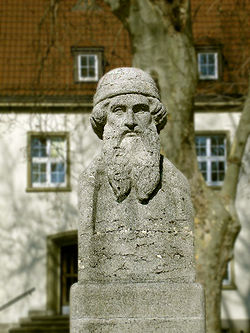历史
The first University of Mainz goes back to the Archbishop of Mainz, Prince-elector and Reichserzkanzler Adolf II von Nassau. At the time, establishing a university required papal approval and Adolf II initiated the approval process during his time in office. The university, however, was first opened in 1477 by Adolf's successor to the bishopric, Diether von Isenburg. In 1784 the University was opened up for Protestants and Jews (curator Anselm Franz von Betzel). It fast became one of the largest Catholic universities in Europe with ten chairs in theology alone. In the confusion after the establishment of the Mainz Republic of 1792 and its subsequent recapture by the Prussians, academic activity came to a gradual standstill. In 1798 the university became active again under French governance, and lectures in the department of medicine took place until 1823. Only the faculty of theology continued teaching during the 19th century, albeit as a theological Seminary (since 1877 "College of Philosophy and Theology").

Statue of Johannes Gutenberg at the University of Mainz.
The current Johannes Gutenberg University of Mainz was founded in 1946 by the French occupying power. In a decree on 1 March the French military government implied that the University of Mainz would continue to exist: the University shall be "enabled to resume its function". The remains of anti-aircraft warfare barracks erected in 1938 after the remilitarization of the Rhineland during the Third Reich served as the university's first buildings and are still in use today.
The continuation of academic activity between the old university and Johannes Gutenberg University of Mainz, in spite of an interruption spanning over 100 years, is contested. During the time up to its reopening only a seminary and midwifery college survived.
In 1972, the effect of the 1968 student protests began to take a toll on the University's structure. The departments (Fakultaeten) were dismantled and the University was organized into broad fields of study (Fachbereiche). Finally in 1974 Peter Schneider was elected as the first president of what was now a "constituted group-university" institute of higher education. In 1990 Jürgen Zöllner became University President yet spent only a year in the position after he was appointed Minister for "Science and Advanced Education" for the State of Rhineland-Palatinate. As the coordinator for the SPD's higher education policy, this furloughed professor from the Institute for Physiological Chemistry played a decisive role in the SPD's higher education policy and in the development of Study Accounts.
Today
Today the Johannes Gutenberg University of Mainz has approximately 35,000 students (as of 2005) and consists of over 150 institutions and clinics.
The range of studies is comprehensive; the university lacks some technical studies, veterinary medicine and nutrition science. One can nonetheless study History of books, athletics, music, visual arts, theatre, and film.
The University of Mainz does not currently levy fees or tuition (Studiengebühren) for a regular course of study. Senior citizen students, auditing students, and certain postgraduate students may be subject to fees. The Ministry for Science and Advanced Education introduced "study accounts" (Studienkonten) that were developed jointly with Prof. Zoellner. During the transition period, overdrafts on the account would incur a flat-rate charge of 650 Euro for every overdrawn semester. The Study Accounts allow for a free-of-charge initial course of study as long as it does not exceed 1.75 times the standard period of study. In a second step the accounts will soon be charged according to time actually used. It is still contested as to whether the enormous administrative burden will lead to an actual improvement of academic conditions. **Measurable success is similar by the introduction of long-term tuition in other federal states and its effect on the decline of nominally enrolled students.
Since 2008 the JGU is home of the editorial office of Management International Review.
Miscellaneous
The University of Mainz is one of few campus-based universities in Germany. Nearly all its institutions and facilities are located on the site of a former barracks in the south west part of the city. The university medical centre is located off campus, as is the Department of Applied Linguistics and Cultural Sciences, which was integrated with the university in 1949 and is located in Germersheim. Also on campus next to the University is the Max Planck Institute for Chemistry and the Max Planck Institute for Polymer Research, and the electron accelerator MAMI, the research reactor TRIGA, the botanical garden, a sports stadium and an indoor swimming pool. Unique in the national higher-education landscape is the integration of the Rhineland-Palatinate Conservatory, the Academy of Visual Arts and College of Athletics at one university.
Since 2007, the university started a web-tv program which also airs its video clips in English. The short videos (two to seven minutes) are specially made for students who are new to the city or university, and do offer information relevant to first year students. This web-tv is unique amongst Germany's universities and can be viewed on a website that is run by students: ersti.tv.
One of the instruments carried by the Mars Exploration Rovers Spirit and Opportunity, a miniature Mössbauer spectrometer, was developed at the university.
Points of interest
- Botanischer Garten der Johannes Gutenberg-Universität Mainz, the university's botanical garden
Alumni
Among the notable alumni from the university of Mainz are German politicians Rainer Brüderle (FDP, Federal Minister for Economics and Technology) and Franz Josef Jung (CDU, Former Federal Minister of Labor and Social Affairs), as well as sports journalist Béla Réthy.
更多
- List of universities in Germany
External links
- www.uni-mainz.de/eng Official English website
- ersti.tv: Web-tv for freshman and foreign students
Coordinates: 49°59′35″N 8°14′30″E / 49.99306°N 8.24167°E / 49.99306; 8.24167



